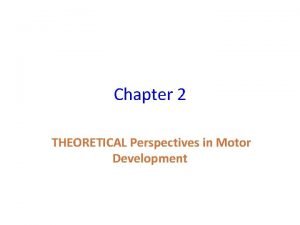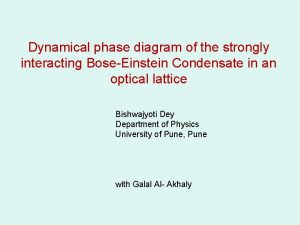DYNAMICAL DOWNSCALING OF WIND RESOURCES IN COMPLEX TERRAIN

- Slides: 1

DYNAMICAL DOWNSCALING OF WIND RESOURCES IN COMPLEX TERRAIN OF CROATIA Kristian Horvath, Alica Bajić and Stjepan Ivatek-Šahdan Meteorological and Hydrological Service, Gric 3, 10000 Zagreb, Croatia Emails: horvath@cirus. dhz. hr, bajic@cirus. dhz. hr, ivateks@cirus. dhz. hr Abstract summary -Parts of continental Croatia, Istria peninsula, Lika and hinterland of Ploče area For reliable wind resource estimates, the global model reanalysis data needs to be downscaled to provide information for regional interpretation. This is especially true in complex terrain of Croatia, where a significant portion of wind energy potential is related to phenomena arising from the non-linear dynamical interaction of the high, steep mountains and the troposphere, such as cross-mountain Bora and along-mountain “Jugo” wind (channeled Sirocco). Interannual variability of mean wind speed is up to 25%. Global model reanalysis data (ERA-40) is dynamically downscaled to 8 km resolution, with the use of full-physics prognostic mesoscale ALADIN/HR model (Žagar et al. , 2006) and dynamically adapted to 2 km grid resolution over Croatia. Verification showed that dynamical downscaling was sucessful, resulting in accurate wind resource estimates in the area. BORA WINDSTORMS ! i) RAPID ONSET& HURRICANE FORCE GUSTS (70 ms-1) In order to estimate the quality of downscaling, conventional verification scores were calculated on 10 m data (Fig. 4): ii) GUSTS > 2 x WIND SPEED iii) NONLIN. FLOW REGIME (Fr<1) 3 CLIMATE REGIMES Figure 3: Spatial distribution of mean wind speed at 10 m (left) and 80 m (right) AGL, as a direct model output of dynamical downscaling. ! Most accurate results are found in flat terrain (bias, rmse ~1% of the mean wind speed value), and the poorest results are present in highly urban areas. In complex terrain, bias and rmse are ~10%. CONTINENTAL, MARITIME AND MOUNTAINOUS Figure 1: Outer and inner domains of ALADIN/HR model setup with model orography at 8 km and 2 km grid resolution and locations of verification stations. Objectives 1. Estimate wind resources of Croatia 2. Evaluate the accuracy of dynamical downscaling for wind resource applications subject to orographically forced non-linear dynamical flows, such as Bora Methods Input data: subset of ERA-40 dataset (1992 -2001) Model characteristics: i) Operational ALADIN/HR, hydrostatic, full-physics (Bubnova et al. , 1995) at 8 km grid resolution and 37 hybrid vertical levels, single nesting ii) Operational ALADIN/DADA dynamical adaptation module at 2 km Output: 10 -yearly period, 1 -hr output frequnecy, final grid resolution of 2 km, wind fields at 10 m and 80 m AGL Verification: i) Conventional (RMSE, BIAS…) ii) Spectral (spectral power) Results of dynmical downscaling are shown at 10 m AGL and at 80 m (Fig. 3). The highest wind resources are found in: -Mountaneous regions (Dinaric Alps, especially Velebit and Plješevica) Maritime areas (west of Dinaric Alps, especially regions prone to Bora, such as Vratnik pass) Figure 4: Multiplicative BIAS (left) and RMSE (right) for sel. stations (cf. Fig. 1). Spectral verification (Fig. 5) shows a rather accurately simulated primary maximum of spectral power due to synoptic scale motions (all terrain). Secondary diurnal (all terrain) and tertiary semidiurnal (coastal stations only) peaks of spectral power are accurately modeled as well. In contrast, spectral power of motions with periods less than 12 h are strongly underestimated. Figure 5: Spectral power of zonal wind component at the coastal station of Dubrovnik (cf. Fig. 1). Conclusions Dynamical downscaling is sucessfully performed. The greatest accuracy is obtained in flat terrain, followed by coastal & mountain areas, while the procedure is least accurate in urban areas. Spectral verification indicates that dynamical downscaling was capable of simulating mesoscale motions, such as evidenced in diurnal and semidirunal peaks of spectral power related to coastal circulations. On the other hand, the intensity of less predictable motions of temporal scales less than 12 h are strongy underestimated Turbulent properties of Bora are to be included into next generation wind resource and annual energy production yield studies. References The lowest wind resources are found in: Žagar N. , M. Žagar, J. Cedilnik, G. Gregorič and J. Rakovec, 2006: Validation of mesoscale low-level winds obtained by dynamical downscaling of ERA-40 over complex terrain. Tellus, 58, 445 -455. Acknowledgement: The study is partially supported by HEP-OIE d. o. o. and UKF grant no. 16/08. Bubnova R. , Hello G. , Benard P. and J. F. Geleyn, 1995: Integration of fully elastic equations cast in the hydrostatic pressure terrain-following coordinate in the framework of ARPEGE/ALADIN NWP system. Mon. Wea. Rev. , 123, 515 -535. 30 th International Conference of Alpine Meteorology (ICAM), 11 -15 May 2009, Rastatt, Germany

